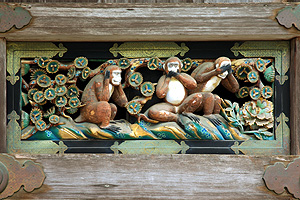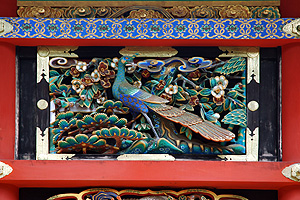Saturday, 6 August 2005
Tokyo, Japan
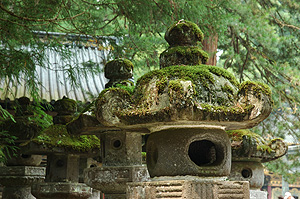
(Nikko, Tochigi, Japan)
After a gruelling fifteen hours of flying we arrived in Tokyo. My expectations of Japan being a country of gadgetry of science fiction level proportions were temporarily set back by the baggage conveyer in Narita which would not have looked out of place in a former eastern block country. We got through the airport pretty quickly and soon were on a train to the centre of town.
From being on the train we quickly realised one key thing about Japan, that quite a lot of it is still countryside. Watching films in the west you would be easily fooled into thinking Japan is one huge conurbation. However Narita, which is 70km from the centre, is surrounded by rice paddies, bamboo groves and tiny hamlets. The large amount of trees was something that I had read about but had not been really expecting, bit was like we had landed in the middle of a forest!!
Once off the train we started to panic a little at the thought of the metro. Looking at a Tokyo metro map you might be forgiven for panicking, the thirteen lines shoot off in all directions and cross each other frequently. It's a bit like a tangled and knotted version of the London tube map. However our fears were unfounded as once in its easy to get around. For a start all stations are labelled in English as well as Kanji and then they are all colour coded and numbered. If this was not enough inside the carriages on some lines there is an electronic board which gives a graphic display of the line with the current stop lit up. Japan at this point started looking a lot more high tech than London.
Changing tube lines was interesting. The hotel we had booked was on the Namboku line so we had to change at Tameike-sanno. It was quite a distance between the two platforms however, Japanese style they had frequent signs telling you how much further you had to go, 420m, 415m etc.
Punctuality is another common feature of travelling in Japan we noticed from day one. Everything is predictable and there is almost too much information to tell you when things are happening. For example the train to the airport was scheduled to arrive in Tokyo at 0827 and that's exactly when it pulled into the station, not a minute late. The same was true with the subway, boards told you exactly when trains would turn up and they did, on the dot. Apparently this was one of the reasons why the Sarin gas attacks in 1995 resulted in so many fatalities. The gas had been let off in one of the carriages and people were falling sick but the overwhelming drive to be on time meant that no-one wanted to stop the trains. The result was that many more people died than needed to.
We got to our hotel around ten, which had the disadvantage that we had to wait until check-in time at three before we could get into our room. So we dumped or bags and headed to a handy branch of Patisserie Paul next to our hotel for a late breakfast. After this we set off to Shinjuku Goyen, a park in the west of Tokyo.
It had seemed like a good idea at the time but we had not made allowances for a) how tired we were b) how hot and humid it was. The gardens were okay but after a while of walking around we started to feel tired and had to find somewhere with some air conditioning. This was easy enough as we needed some lunch so we wet to a sushi restaurant Shion not too far from Shinjuku station.
It was a great choice, the full conveyor belt experience in its original form. We sat around a counter in the middle of which three sushi chefs worked making up plates of various dishes which they periodically dumped onto the conveyor. After lunch we went to check out a camera shop and found a cornucopia of kit at Yodobashi with some genuine bargains.
Back at the hotel we checked in and then immediately fell asleep. Jet lag had taken its toll and we were dead on our feet by 1600 (0800 in the UK). However if we were to stand any chance of adjusting to the time zone we could not sleep too long, so forced ourselves to wake up again at 1930. We then had a walk around Roppongi and had dinner in Gonpachi, a fake Edo period inn complete with wooden beams and two balconies of dinners.
Sunday, 7 August 2005
Nikko, Tochigi, Japan
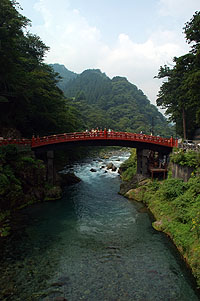
(Nikko, Tochigi, Japan)
We purposefully woke up at 0600 to get out of Tokyo early and go to Nikko, a town in the mountains with a series of revered shrines. A couple of precise subway journeys took us to Asakusa a railway terminus in the North of the city from where we caught the train. The train ride took a couple of hours and again within half an hour of leaving the capital we found ourselves speeding through paddy fields and small sleepy hamlets.
Nikko itself was a bit bigger than the average hamlet, a series of tourist shops lining a road climbing up to the base of a tree covered mountain on which the shrine is built. The walk up the road was hot and sticky. Tokyo itself was unbearably humid and we expected it to be better at an altitude of 600m but sadly it was not. There was not even a hint of a breeze and at 0900 the temperature seemed in the thirties.
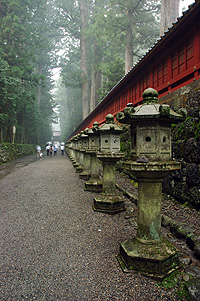
(Nikko, Tochigi, Japan)
After fifteen minutes we got to a beautiful red bridge over an incredibly blue mountain river and the base of the stairs up to the shrine. We climbed up even further and finally got to the entrance, a beautiful ancient stone gate in the midst of a wood of 100 foot pine trees. The atmosphere was incredible, mystical enough that even the hordes of Japanese tourists did not dampen it at all. The surrounding walls were covered in moss and a small stream burbled down channel to the side of the pathway.
Inside the first court way of the shrine we found the first of a series of stone lanterns. These were incredibly photogenic and turned out to be dotted all over the shrine. We the climbed up to the second courtyard and had some water from a copper ladle resting on a small stone trough. After this we visited a small side temple the roof of which was painted with a dragon before climbing yet another set of stairs to the final courtyard. Here we visited the main shrine which ad the most ornately painted ceiling. Sadly we were not able to discern much of what was going on here because the monks were dishing out explanations only in Japanese. The final climb of stairs was the worst, nearly two hundred stairs to get us to a small shrine hiding in the woods.
The most amazing bit of our tour was to come when we reached the bottom of the stairs again. We sat down to catch our breath back in one of the shrine's many courtyards when suddenly the heavens opened and it started to pour. In the end we were stuck sitting on a step in this courtyard for about an hour. This gave me plenty of time to sit and look at the temple and get familiar with the functions of my new digital SLR. At the beginning a lot of the Japanese were stuck there with us, but one by one they seemed to acquire umbrellas from a lucky umbrella seller somewhere in the temple and slowly drifted off. We on the other hand sat it out and were rewarded with a break in the rain and a chance to walk back into town in relative dryness.
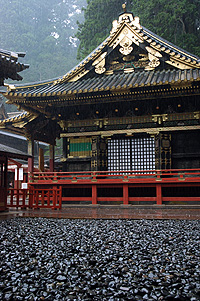
(Nikko, Tochigi, Japan)
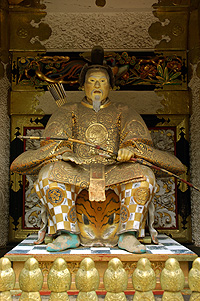
(Nikko, Tochigi, Japan)
Back in town we found a nice traditional restaurant to sample the local speciality - yuba ryori - bean curd rolled up to form tubes like noodles. Anna managed to get the last portion of this so I was left with ten don a bowl of rice with some tempura prawns.
By the time we finished lunch it was pretty late so we decided to head back to Tokyo. It took the bet part of three hours to get back so when we did there was little time before we ha to get dressed up and go out for dinner. For this we found a restaurant on the 42nd storey of one of Tokyo's many sky scrapers. It was amazing, like a scene out of blade runner, towers rose for miles around topped by blinking red lights. The dinner itself was not as fun as the night before but was definitely more polished. We had clams, raw mackerel, some very tender octopus and some deliciously cooked pork. I managed to resist the biggest temptation on the menu, deep fried whale meat, a bit of a moral dilemma as I was quite intrigued!!
Monday, 8 August 2005
Tokyo, Japan
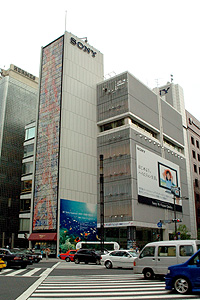
(Tokyo, Japan)
We had woken up very early the morning before in an attempt to combat jet lag. Having achieved this we decided it was the day to have a lie in and did not wake up until eleven. We did not have much on our agenda except sorting out the next hop. We had realised that Japan is a pretty big place and we could not cover all of it even in three weeks so we had to either go North or South. To the North was the tempting wilderness of Hokkaido but to the South were the most significant cultural sites. We were very torn between the two but in the end decided to go South as we could find wilderness anywhere and so were more interested in what town's like Kyoto had to offer.
Tokyo station was an exercise in map reading. The subway line exits a little way from the station and in order to get from one to the other you had to find a small tunnel. We failed to do three times in a row always ending up back in the same place - the domed entrance of the Marunouchi line. Finally we found it but even then our tribulations were not over. Surprisingly for Japan not enough people spoke English in the railway station and despite going to several desks no-one could explain to us if there was some combination of rail passes that would make the coming trip any cheaper. In the end we decided to go by what the book said which was that for what we were doing we should have got a Japan Rail pass before we came and that the regional variants that were available inside the country we were unlikely to make any saving. So we just purchased a ticket on the Shinkansen (bullet train) to Kyoto and Osaka for the next morning.
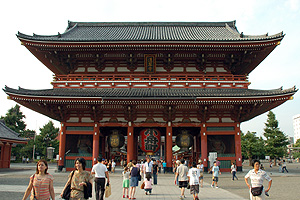
(Tokyo, Japan)
After this we decided to do a bit of window shopping in Ginza. The first stop was sadly Muji where Anna bought a skirt and I bought a flannel. The story with the flannel is quite complex. As I have said Tokyo was unbearably humid, no real surprise for August. What was surprising however was the fact that the locals were having just as hard a time of it as me. Well some of them at least, it appeared that whilst some of them were perfectly happy waltzing around in wool suits in the sweltering suits others were sweating profusely. They local antidote to sweat however was to carry around a small flannel to wipe your face with. I thought it was a bloody good idea and decided that when in Rome...
The next stop was the Sony store, seven floors of extreme gadgetry. We spent a pretty fun hour or so in there checking out the latest in terms of huge plasma screens and tiny cameras and MP3 players. My favourite toy was an MP3 player no bigger than a cigarette lighter with 1GB of memory - enough to store as many albums as you would ever need but not as much as an iPod - yet!! We also spent a lot of time playing with the robotic dogs. They reacted realistically to words and being stroked, however Anna managed to get one to completely cease up, its head buried in its paws. After this our last stop in Ginza was Kyokyodo, the Japanese equivalent of Paperchase, to look at the writing brushes and paper.
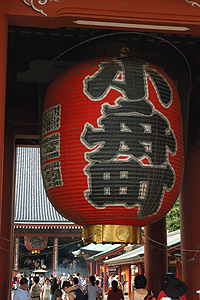
(Tokyo, Japan)
We then descended back into the subway to go to Asakusa. Although we had been there the day before on our way to Nikko we had not explored so we decided to take a look around the area and Tokyo's main Shinto shrine the Senso-ji. It was not as exciting as was made out in our guide book. The small market of tat before the shrine was very well organised and the shrine itself was swarming with people and set, communist style in a large concrete square rather than in woods. We sat down to rest outside the temple and were immediately accosted by a very weird Canadian who was working in Japan and seemed very desperate for company. We chatted for a while but in the firmly said our goodbyes and went off to find some dinner.
Dinner was an extra special treat Shabu Shabu at a restaurant called Chin-ya. A very simple, but incredibly tasty, concept it consisted of a bowl of water sitting on a gas burner on your table, in which you boil vegetables and slices of beef. You then dip the beef in either a soy sauce or a sesame seed sauce, not unlike a satay sauce, sprinkle on some chives and then eat it. All sounds quite simple until it came to the beef which could be ordered to three levels of quality. The Japanese names of which I cannot remember but basically translated as "orchid" (the best and most expensive), "chrysanthemum" and "bush clover". We went for the middle one as the top grade was very expensive (our meal would have easily cost Y130) and "bush clover" did not sound too attractive (although the standard was so high bush clover would have probably put what you get served in the top UK steak restaurants to shame).
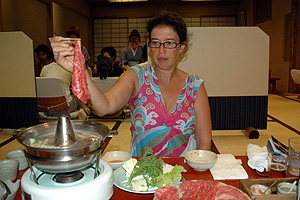
(Tokyo, Japan)
When the meat came out I was dumb struck. In the UK peoples' instinct is to buy the reddest beef thinking that it is the best. However it is much better to go for beef which is "marbled" with veins of white fat as this fat does wonders for the taste. The beef we were presented with was marbled to the extent where it almost looked like corned beef. When cooked lightly in the broth it had an incredibly delicate taste, enhanced by the sauce. It is impossible to explain how incredible it was, but yet again the simplest high quality ingredients had been put together to achieve a spectacular effect.
The meal was only enhanced by the surroundings. Our first traditional Japanese restaurant, we had removed our shoes at the entrance and had been taken upstairs by a waitress in a kimono to a tatami room. We had to sit cross legged at a low table and the waitress patiently knelt by the side of the table whilst we tried to figure out the menu. One thing that I found amusing was the toilets. I had wondered how shuffling around in your socks or bare feet in public toilet would work out. Towards the end of the meal it looked like I was going to find out. However when I opened the door of the toilet I found two pairs of grandad slippers just by the entrance - mystery solved!!
We had eaten pretty early so decided to head back to Roppongi for a beer. We found a totally ex-pat bar around the corner and sat drinking beers outside listening to Depeche mode and watching some salarymen entertain their western guests by attempting to out drink them. It being our first week day in Tokyo we were pretty amazed by how late everyone seemed to work and even at eleven there were still people commuting home who had clearly not spent the evening drinking.
Tuesday, 9 August 2005
Kyoto, Japan
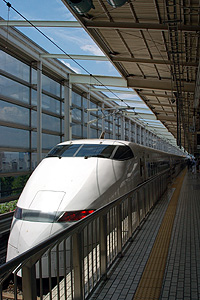
(Kyoto, Japan)
Although our Shinkansen was at 0906 we had set the alarm very early in order to give ourselves plenty of time to get through the morning rush hour. In the end it was not so bad. The men employed to push people on the train were nowhere in site and we managed to fit ourselves an our rucksacks into the carriage with no problems. We attempted to avoid the long walk between the Namboku and Marunouchi lines at Tameike-sanno by taking the Ginza line to Ginza and switching there. However it was still a 280m walk so we only saved 200m of underground walking!!!
The shinkansen was pretty amazing. We were rocketed through the endless conurbation that stretches between Tokyo and Ngoya at speeds of 260kph. The cornering was at alarming angles and in general it just reminded me of the UK's failed attempt at reproducing the success of bullet trains, which resulted in millions of pounds being spent on trains which ultimately could not tilt at the angle required. Disappointingly we failed to see Mount Fuji as it was a very misty day.
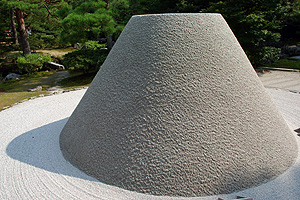
(Kyoto, Japan)
In Kyoto we had the same problem we had in Tokyo, we could not check into the hotel until three. So we decided to check out a couple of things in the tourist office in the station then went to drop our bags off at the hotel. The hotel, in fact a Ryokan or Inn, was interesting but a bit of a disappointment. Due to a bit of a mix up we had not realised they had doubled the price as it was the height of the holiday season. This had the effect of turning a slightly run down, traditional hotel into an overpriced dump. The three sisters were in fact still running the place and manifested themselves as three old women who gave out long lists of what to do and what not to do including a 2300 curfew. The only good thing about the place was that it had tatami flooring, paper screens and a Tokonoma or sacred corner. So it was a bit more Japanese than the western style hotel where we had been staying in Tokyo.
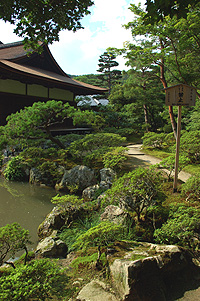
(Kyoto, Japan)
We still had a few hours to go before check in so decided to go to one of the local sites Jinkaku-ji or the silver pavilion. Kyoto, the capital of Japan for 1000 years until the mid nineteenth century, has 1600 temples and shrines so we were in no particular panic to try and see everything. On the way we stopped for some lunch at Omen, a very nice udon restaurant where I also had some green tea ice cream. The temple was predictably swamped with tourists and this someone distracted from the Zen elements of sand sculpted into cones and waves. One thing that was to continue to annoy us at these temples was the fact that your passage through the place was strictly controlled. Although there were all sorts of interesting side routes these were all shut off by bamboo railings which herd tourists in one direction through the attraction.
We took the bus back to the hotel, checked-in and showered. As we had been told we were of course careful not to get any water on the tatami to prevent rot and no make-up on the towels!! Then we went out for dinner. This did not go particularly well as I forgot my wallet and Anna did not have enough cash so we had to spend about an hour finding a cash point which took Maestro. We then went to Pontocho, a street or restaurants with balconies overlooking the river. By the time we got there we found that most of the restaurants were full and were forced to go to a pretty dismal joint which, although it had a balcony, side stepped having to do any cooking by giving guests a mini tabletop barbecue on which we had to cook our own food. It sounded good in principle but did not do much to keep the temperature down and unlike shabu shabu took hours. It was all in all a pretty lame first day in Kyoto.
Wednesday, 10 August 2005
Kyoto, Japan
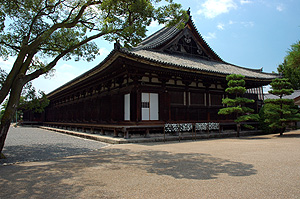
(Kyoto, Japan)
We got up relatively late and decided it was the day to bag a few more temples and shrines. We got to our first one using the buses which were very easy to use. The stops are announced in English and the bus maps are easy to understand. Quite amazingly they also have a little board at the bus station on which a series of disks light up to show you how far your next bus is away. Again it is all highly efficient and well run.
First stop was Sanjusangen-do. Japan's longest wooden building it contains 1001 near identical bronze statues of the god Kannon made in the 13th century. The statues were arranged in ten rows of one hundred statues, making for quite a long walk. Each statue id apparently slightly different and with a bit of concentration you could make out some differences in the eyes, the clothes etc. Each statue apparently had 21 pairs of arms each capable of saving 25 worlds, from what I was not entirely sure.
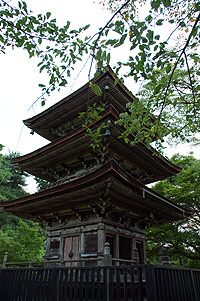
(Kyoto, Japan)
Next we had a short walk to Kiyomizu, a wooden temple dramatically set at the top of a wooded valley. Unfortunately the midday light was working against me here and I did not manage to get a decent photo but it was a stunning setting, only slightly marred by the large number of people swarming all over it. We walked once again within the channel layed out for us. First through the temple then round the head of the valley to a small pagoda set in the woods.
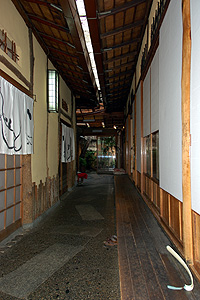
(Kyoto, Japan)
After this we took a walk through the oldest surviving parts of Kyoto. Here we were to see streets with the original Machiya houses. Literally meaning "bedrooms of eels" these houses were a response to a tax imposed on the size of the front of a building. At the front they have a narrow shop front but behind this go back for a long way with a series of rooms and internal courtyards.
Following this we had a very traditional Kyseki lunch at Imobo Hirano-ya Honten. This turned out to be more a feast for the eyes than the taste buds. The restaurant itself was amazing, from outside it looked like a ramshackle old building, every bit what you would expect a 300 year old wooden building to look like. But inside it was a spotless series of individual tatami dining rooms in which kimono clad waitresses served sets of dishes in small bowls. The signature dish was Imobo, a portion of dried eel with the most unusual potato ever. As I said it was very light and mainly vegetarian but unfortunately as I said it was a bit on the bland side.
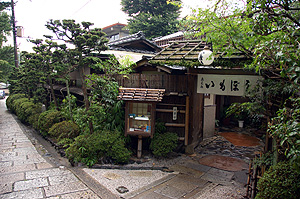
(Kyoto, Japan)
Our final stop of the day was Kinkaku-ji the golden pavilion. As we rounded the corner from the ticket office the glint of the gilded sides of the pavilion reflected in the lake it stood on immediately caught our eye. The lake contained a couple of small islands with sculpted pine trees and every now and then a rock stuck out from the surface. You could not help thinking that it had taken years of intricate planning and landscaping to build these gardens and provide a haven of tranquility for the Shogun Ashikaga Yoshimitsu. However it was no haven of tranquility for us, again it was totally mobbed and we were herded between bamboo railings. Although I managed to get a couple of decent photos the light just started to get a lot better as we were leaving. Sadly however stuck in our rat run we were unable t get back to the start and the amazing views of the pavilion by the side of the lake.
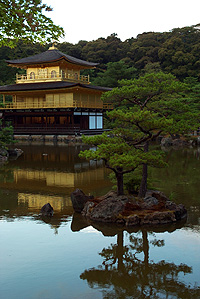
(Kyoto, Japan)
That night I calculated that our overwhelmingly vegetarian diet so far meant that we had to go to eat at an Irish pub, and Kyoto by luck has two. So we set off in search of Tadg's Irish Pub. This was no easy task as finding anywhere in a Japanese city is like a three dimensional maze. The Japanese think nothing of having bars or "private clubs" on any floor of a building an each building has an illuminated sign running up the side of it advertising what is on each floor. Thus walking around you not only have to look left and right but also up and down and be prepared for the sign being in katakana only. When we eventually found it we were not at all surprised that it looked like a block of flats and getting out of the lift we found ourselves in an average residential lobby. In the lobby were doors and signs for a couple of bars and one of these opened out into a full blown British pub complete with wood paneling and beer barrel tables.
After a few pints of Kilkenny and a beef and Guinness stew we were off to our final resting place, the "Rub a Dub". A compact reggae beach bar the place has to be seen to be believed. Despite being in a basement the owner had conjured up nights in the Caribbean by painting the ceiling black, putting a tin roof over his bar and serving Red Stripe. There were about twenty people in the place and it was already full yet they still had a DJ who had a back catalogue of vinyl that surprisingly included a large number of singles. If it had not have been for our 2300 curfew we would have stayed a lot longer.
Thursday, 11 August 2005
Kyoto, Japan
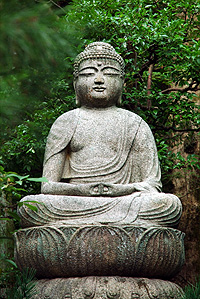
(Kyoto, Japan)
We had decided to get up early to see something we had missed out on the evening before. Ryoan-ji contains the most famous Zen garden but as with a lot of the sites in Kyoto is said to suffer with the crowds. So we dodged this by turning up at 0900 and we quickly realised this was the way to see anything in Kyoto. There was practically no-one there and we were free to contemplate as long as we liked.
The gardens themselves were well arranged with another pool, this time filled with lilies, and strategically placed islands. But the real stars of the show were the small gardens in the temple itself. Between the front of the temple and its enclosing wall was probably the most famous Zen garden in Japan. A rectangle of about 10m by 4m was covered in neatly racked gravel and within this fifteen rocks had been placed. Apart from this the only other thing to look at was the moss growing around the base of the rocks. Apparently through hours of contemplation we would get to understand the meaning but without that luxury we were forced to content ourselves with observing the well known fact that there is no one position from which you can observe all fifteen stones. Well actually I did find one spot but I thought it better not to mention the flaw.
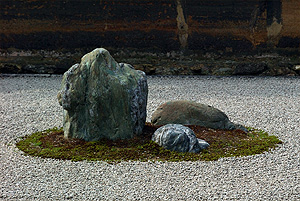
(Kyoto, Japan)
Around the corner from Zen rock garden was a moss garden. This was equally well laid out and an immense contrast from the rock garden. We again sat there for a few minutes contemplation before going to the back of the temple where again a scene with a waterfall and a small stone water trough had been laid out. Of all our temple visits this was the most rewarding as it was without a doubt the most peaceful.
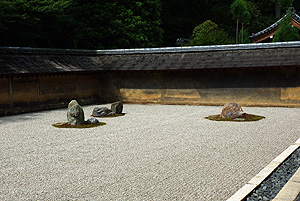
(Kyoto, Japan)
After we left Ryoan-ji we got on a bus for the train station as we were heading to a nearby town called Nara. Like Kyoto, Nara had a spell as capital before Tokyo and this has left it with many shrines and monuments. When we got there it turned out to be a long walk from the station to the park containing the monuments so halfway up the long central street we decided to stop for some lunch. We went to a restaurant specialising in an Oskana dish called Okonomiyaki which was basically a very nice omelette with a choice of filings and covered with some interesting form of seaweed. It was cooked on a hot plate but we also had a hot plate built into our table which kept the food warm while we ate it.
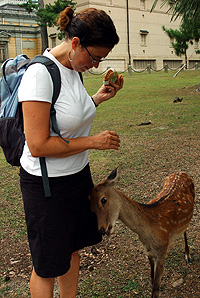
(Nara, Kyoto, Japan)
When we finally got to the park the afternoon temperature was stifling. One feature of the park was the huge number of deer roaming around in it. Enterprising locals had small stalls selling strange biscuits which the deer like to eat and since the deer were so tame already we bought a pack and fed some of them. It was pretty amusing at first but the female deer had a tendency to rub their heads on you like cats a the male deer had such huge antlers that being gored was a potential hazard. After a few minutes a huge herd of them had built up so we decided it was best to run off and stick to feeding lone deer in future.
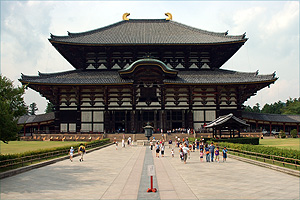
(Nara, Kyoto, Japan)
After a bit of walking around in the park we headed off to see Todai-ji. The temple, first built in the eighth century and last rebuilt in the eighteenth century is the world's largest wooden building. It has to be because it also houses Japan's largest bronze Buddha the fifteen metre high Daibatsu. It was an immense seated figure and as usual had a supremely serene face. In the corners of the temple were four wooden statues of various guardians which were themselves at least five metres tall and so almost as impressive.
We could have seen a lot more but the humidity really started getting to me so we had to stop. Besides which we were pretty "templed out" and in need of a change so we set off back to Kyoto. Halfway back to the station we stopped at the Nara tourist information to make a couple of calls about our next couple of destinations. This is where we started to hit the language barrier. Contrary to what we had expected very few people in Japan speak English. Okay it was probably as a percentage more than the number of people in England who speak any other language, but still it was quite surprising. Now we had found the ultimate example, Anna had called the tourist information in a town and they spoke no English. Anna tried to rope in someone else sitting in the office to talk to the people but they did not speak English either. In the end we had to give up.
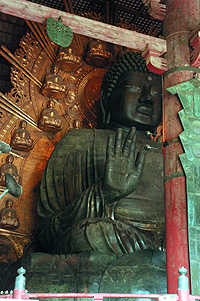
(Nara, Kyoto, Japan)
Back in Kyoto we went back to the hotel and then changed for dinner. On our way to the restaurant we passed through a residential district where cycling was all the rage. The residents even had double decker cycle racks on the street corners. One thing that I should mention about cyclists in Japan is that they tend to cycle on the pavement which had resulted in a few near misses. Whether they were meant to cycle on the pavement we were not sure but we did note that whenever they cycled on the road motorists would honk their horns and generally try to force them off the road, so the result was that they terrorised pedestrians instead!!
Tonight it was back to Japanese and we had decided on Teppanyaki, which basically meant cooking on a hot plate. It was very nice and the owners were very friendly. Like a Mongolian barbecue or a wok joint you picked your own meats, vegetables and sauces and then they went to work. And like our Irish pub dinner the night before it was a lot more reasonably priced and more tasty than the Kyseki we had for lunch the previous day.
Friday, 12 August 2005
Koyasan, Wakayama, Japan
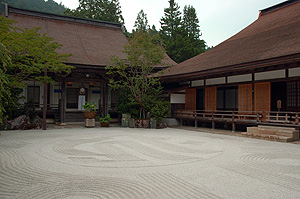
(Koyasan, Wakayama, Japan)
We woke up relatively late as we were heading not too far away and did not need to get an early start. We had some breakfast with the other residents of the Ryokan, predictably all foreigners and then set off. We were heading for Koya-San, a valley in the mountains to the South of Osaka which has fifty three monasteries a large number of which rent out rooms to "pilgrims". We were hoping to find a cooler climate and possibly some Obon festivities.
The first leg of our trip was a short hop from Kyoto to Osaka. The journey was livened up by the fact that we were standing behind the driver's cabin which we could see right into. Every do often the driver would run his fingers across a table of numbers above his wheel an look at his watch in a very demonstrative manner. At first I wondered what it was all about, but then I realised - the table indicated the times the driver had to reach various waypoints. Moreover the actions were all a show for the passengers, he was showing the watching passengers where he should be and that he was hitting all his targets one by one!!
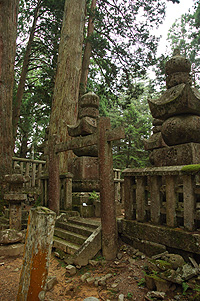
(Koyasan, Wakayama, Japan)
After this we got a subway across Osaka to another train station and then a train out into the countryside. The suburbs of Osaka seemed to last for ages but before long we were climbing up through an ever narrowing mountain valley perched on tracks high above a stream. Eventually the train reached its terminus and we all transferred to a funicular (which Japanese people very confusingly call a cable car). This went up at an angle of 45 degrees and took about ten minutes. We then transferred to our fifth and final mode of transport, a bus, which took us along a few kilometres of winding mountain road to Koya-san.
Koya-san was an idyllic mountain village with a very bearable temperature somewhere around 25 degrees C. The majority of buildings were wooden, and there was very little traffic. However my worst fears about travelling in Japan during Obon were about to come true. We had purposefully not booked because of the disappointment in Kyoto, however as a precaution we had called the day before and had been told there were no problems with accommodation. But when we got to the tourist office in Koya-san we were told that whilst there was no problems finding a room that night, come tomorrow everything was completely booked out. We soon found out why, it appeared that Saturday was the main day of the festival and not the 16th as we had thought. We could not be too sure but it seemed very suspicious given that tomorrow was also a Saturday.
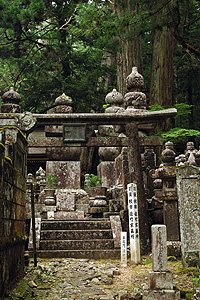
(Koyasan, Wakayama, Japan)
Anyway there was nothing we could do about it so we just found what we could for that night. This turned out to be a very nice place and right on the edge of town so it gave the appearance of being in the woods. Our room consisted of a 3m by 3m square separated from other people's rooms by sliding screens. Just outside our room was a sliding window which overlooked a beautiful garden in the centre of the monastery. When we arrived our room only had a table and two back rest only floor chairs, later we found these had been swapped for a futon. It was in every sense the monastic life style.
We went for a short walk then came back for dinner at 0600. This was totally vegetarian and consisted of a bewildering array of small dishes (about twelve in total) of various tofus, soups and seaweeds. We even had some tempura which included what looked like a battered nettle leaf. It was nice but lacking in meat!! As we were finishing dinner the 84 year old mother of the chief priest appeared with a microphone and started to tell us stories, in English, about when she was a girl and the various things that had happened in Koya-san over the years.
When this was finally over we got to do what we had been trying to do all evening. Koya-san is the home of Shingon Buddhism and its followers and those of other Buddhists sects are buried in Koya-san's vast cemetery. It stretches for almost two kilometres of a vast cedar wood and over 200,000 stone monuments are scattered between the trees. At night it is lit up with lanterns so we decided to take a walk through it. The atmosphere was electric, the stone pinnacles of memorials looming in the darkness with gigantic cedars rising 60 or 70 metres above us. We walked for a while but on the, as we found out incorrect, advice of a tourist map decided to turn back at the Naka-no-hashi or second bridge in order to get back to the monastery before curfew. Once back I had a shower in the communal baths and wandering back in the Japanese robe I had been supplied through the corridors of the temple I felt very monk like.
Saturday, 13 August 2005
Koyasan, Wakayama, Japan
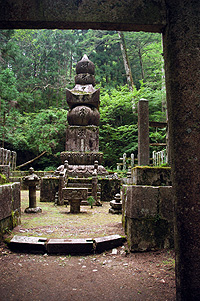
(Koya-San, Wakayama, Japan)
We had gone to bed relatively early so it was not too much of a struggle to get up for the 0600 service in the monastery shrine. With one other westerner and several Japanese guests we sat cross legged in silence for about ten minutes and then the monk rhythmically chanted for about twenty minutes. After this we were given a sermon on how the structure of water can be changed by being nice to it. The chief priest was a fairly entertaining guy but it mainly served to remind me how uncomfortable sitting cross legged on floors is. After this we skipped breakfast and headed for the cemetery again to get some photos.
This proved rather difficult as the light was very poor and there were a lot of mosquitos about. We did however get to walk to the end of the cemetery where we found the mausoleum of Kobo Dashi, the founder of Shingon Budhism. This was a pretty spectacular place as it contained ten thousand oil lamps kept constantly alight. I was a bit miffed that we had not carried on with our walk the night before as it was not as far away as the maps had showed us and it would have been even more atmospheric a place to come across in the dark. After our second trip to the cemetery we had another walk around the town pretty well avoiding going inside the various temples as by now we had clocked up quite a number of them. Then that was it, it was time to leave, which was a shame as it was the first place I had been comfortable with the temperature since we had arrived in Japan.
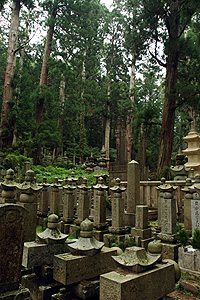
(Koya-San, Wakayama, Japan)
We caught the train back to Osaka's Namba station and exited into a frantic shopping mall a little confused about where our hotel was. We found it after a while buried in amongst the shops and amusement arcades and checked into what was very nice western style room. This was the bizarre thing that I had not quite worked out yet, it seemed that hotel rooms were much better value for money in large towns. Although Koya San is a special place we had paid Y95 the night before for a square mat of tatami, no bathroom and screen walls between us and our neighbours. In Osaka we were paying Y90 for our own room with a huge bed and fantastic bathroom.
After dumping our stuff we headed for Osaka's aquarium. This is considered the best in Japan and certainly when we got to the place, out in Osaka's docklands, the queue reflected this. It was to be expected as the whole Obon weekend is a sort of national holiday but all the same it was pretty horrific. You had to queue to get inn, queue to get up the escalators then queue at each of the tanks to get a look. However there were some pretty unique specimens. The huge central tank contained a whale shark and a manta ray. We felt they were a little too large for the tank and so were a bit sorry for them. Also there was a tank containing a sun fish, something I have only ever seen before on hand drawn charts of fish for divers, and which much more weird than you could possibly imagine. Then there was a tank of spider crabs, which was very alienesque, and finally a room full of different species of jellyfish. It was well worth the visit but mostly reminded us how we needed to go diving again.
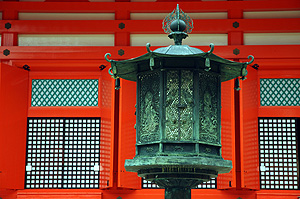
(Koya-San, Wakayama, Japan)
Back in town we went for dinner in a "restaurant department store", eight floors of different kinds of cuisine. I decided to plump for Sukiyaki, which is a bit like Shabu Shabu but you fry the beef in sake, soy sauce and sugar before dipping it into raw egg and eating it. It was okay but the service was a bit more abrupt than the place we went in Tokyo.
The last job of the night was the laundry. Apparently because of Obon the hotel laundry service was not working so we (well Anna mostly) were forced to wash our clothes in a washing machine tucked away on one of the floors.
Sunday, 14 August 2005
Himeji, Hyogo, Japan
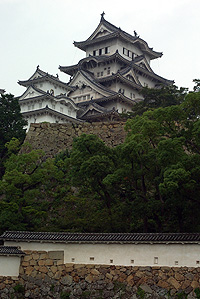
(Himeji, Hyogo, Japan)
We had decided that owing to humidity and overcast weather there was not much point heading to Western Honshu and that we would be better off heading back North to Chubu. Because of this we were not going to be passing through Himeji. However we still wanted to go to its castle so decided that we would go there and back as a day trip from Osaka.
The train journey was again super efficient and painless. On the way we passed the Akashi straits suspension bridge which at 3.9km is the longest suspension bridge in the world. However today we could only see a fraction of it because mist had cut down visibility. We realised that we would not have seen much of the inland sea had we gone to Western Honshu so really had made the right decision heading back North. At Himeji it was very short bus ride to the castle and so we got there around eleven.
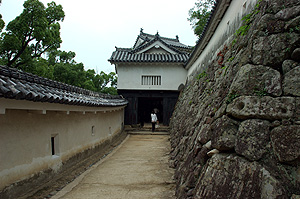
(Himeji, Hyogo, Japan)
Himeji-jo is famous as being one of the most intricately designed fortresses in the world. It has a huge number of gates and walls and the approach up to the central keep doubles back on itself many times. This allowed any defenders unlucky enough to loose one gate to fall back down a passage to the next and enjoy the benefits of being able to shoot at attackers coming up the passage from arrow slits in the passage walls. Once through eight or nine gates the attacker would then have to tackle the central keep, which with six levels offered yet more opportunities for defence and retreat. Himeji-jo was unsurprisingly never captured. In terms of scale the castle was nowhere near as impressive as the crusader fort Crac des Chevaliers in Syria. However the design probably made it just as impenetrable - well except for the fact that it was wooden so could have been torched quite easily!!
The trip back was again painless but we had a lot of problems finding our way back to the station. The problem was that there are about three rail stations and three subway stations called some combination of the words Umeda and Osaka all within 500m of each other connected by a warren of underground passages and shopping malls. In Tokyo the signage was perfect, telling you exactly where to go and how far it was. In Osaka it is generally a bit patchier and you can follow a set of signs only to have them run out half way at some crucial junction. We probably lost a good twenty minutes going around in circles before we found the Misoduji line and our way back to Namba.
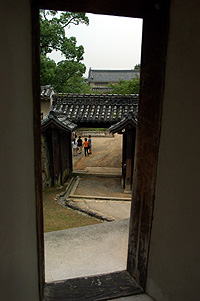
(Himeji, Hyogo, Japan)
We were back at the hotel by about three and had some time to relax and book up our forward accommodation in an effort to avoid another Koya-san like disappointment. We had been studying the guide books quite a lot that day and had identified the Chuo line from Nagoya to Nagano as the train line with the most possibilities. Anna managed to make a couple of bookings using snippets of phrases from the guide books and so we were set.
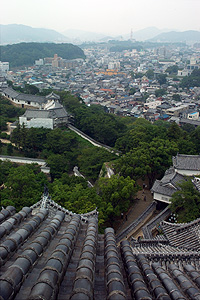
(Himeji, Hyogo, Japan)
As it was our last dinner in a big city for quite a while we had decided to go western again. We found a really nice Africa themed restaurant serving modern European style dishes and had a five course set meal for Y15 a head. The standard was very high and all in all it was a bit of a result. After this we went for a pint of weiss beer at the Kirin Plaza Osaka, a micro brewery just round the corner from our hotel. Whilst we supped it we were treated to a video on English brewing techniques which, judging by the hilarious hair styles was clearly made in the early eighties!!
On the way back to our hotel we started to investigate our surroundings a bit more. As I have said our hotel was in the midst of one of the most lively districts of Osaka and the covered street/mall we were on seemed to be thronged with people at all times of the day. There were karoke places, restaurants serving all sorts of snacks and several vast amusement arcades. It was the arcades that most caught our eye because inside they were packed with people playing what looked like slot machines but they were surrounded by baskets of ball bearings. Feeling brave after a few beers we decided to investigate and found they were all playing something called Pachinko, a game where you simply drop ball bearings into the top and get points depending on where they ended up. It was incredible that in such a sophisticated country everyone should be addicted to such a simplistic game. Admittedly the Japanese had added a few bells and whistles but it was a game I had not seen in the UK since I was a kid, very odd!
Monday, 15 August 2005
Magome, Nagano, Japan
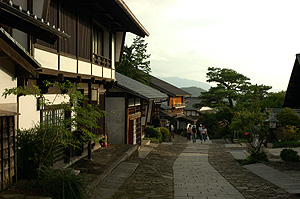
(Magome, Nagano, Japan)
We were getting very confident of journey times being short and check in times being late so decided that we were not in a rush to get to the next destination. We slept in for a while and had breakfast at Starbucks before making our way to the station. There we had a couple of errands to run, we got some cash at the Post Office (as we had discovered the only bank which can be relied on for taking Maestro) and then I popped to the Osaka branch of Yodobashi. I had switched to a digital camera just before the trip and had only bought a single 1GB card. Although this was enough for 170 photos I had already used up 70 and this was with some fairly cut throat pruning of less than perfect photos. I suppose I could have got them all ripped to CD but as always the temptation to buy more toys was too much to bear. As it turned out a 1GB compact flash was about Y80 - pretty much what it costs in the UK.
At the station, Umeda once again, we had a pretty hard time getting a ticket. First we tried booking a seat on the Shinkansen to Nagoya followed by a seat on the "limited express" up the Chuo line. However this worked out horrifically expensive and confusingly involved three tickets - one for the entire trip and two covering the extra expense of the Shinkansen and the local train. We then tried the cheaper option of going on local trains and had it all paid for and sorted out before it was revealed that we needed two changes of train to get to Nagoya which would take us three hours compared with the Shinkansen which took thirty minutes. We decided in the end to strike a balance between cost and speed - an unreserved ticket on the Shinkansen followed by the local train to Natasugawa, our final destination. Although very efficient and easy to use it was clear that the number of price options available on the Japanese rail system rivals that of the Chinese.
At Natsugawa we missed the connecting bus so had to wait an hour but the time flew past and before long we were heading up into the mountains for Magome our final destination. Like Nikko, Himeji-jo and Nijo-jo in Kyoto, Magome is yet again a creation of Shogun Tokugawa Ieyasu. Having reunified Japan after a series of civil wars lasting150 years, succeeding where the weakened Emperor had not, he decided that he needed five highways linking his administrative capital Edo to all corners of his empire. Along these highways he built juku or post towns and Magome is one of three surviving juku in the Kiso valley which have been restored to pretty much their original Edo period state.
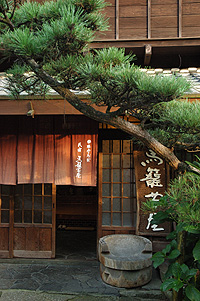
(Magome, Nagano, Japan)
We arrived at around four and struggled up the steep cobbled street of the town to find our hotel. There were quite a few tourists around at this time but as the afternoon wore on the numbers dwindled until we were practically the only people left. The hotel was very nice, we had a completely spotless tatami room, this time with no small paper signs everywhere! From the looks of things it had been recently refitted as all the wood work was brand new cedar.
As soon as we arrived we had a quick wash. It is worth at this point taking some time to explain how Japanese communal baths work. Basically a bathroom in Japan consists of several hand held showers and a large tub of hot water. The way it works is that you first cover yourself in soap then wash yourself completely in the shower and then go for a soak in the tub. The bath water remains in the tub all day so thus the need to get completely clean before entering it. You also need to be careful to remove all traces of soap so that the bath water is completely pure. It sounds a bit whacky but its a bit of a notch up from having just a shower and the water in the tub is kept very hot. Mind you at this point I as not at all certain what would happen if some other dude wanted to get into the bath while you were using it. At the Magomejaya guest house bath time was made extra special by the fact that the bath was a traditional square cedar wood bath. This sounds like it would get a bit grimy but in fact is very clean (cedar is apparently a natural antiseptic) and a lot nicer the touch.
After cleaning up we had a short walk around the village and then went for dinner at 1800. Dinner was again of the complex type featuring 16 different bowls containing different vegetable, meat, rice and noodle dishes. The new treat this night was raw beef which you dipped into a soy sauce and ate. After dinner that was pretty much it for the night. We had another short walk in the village but by then all the shops were closed, no-one was around and it was pitch black (the Japanese do not have DST) so we had little else to do but to retire to our room at around seven!!
Tuesday, 16 August 2005
Magome, Nagano, Japan
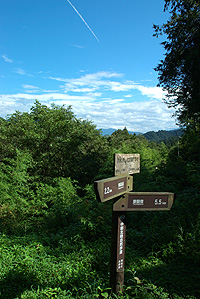
(Magome, Nagano, Japan)
We woke up early with the sun shining through our window and went down for breakfast at 0700. I think it was the first Japanese breakfast we had actually had and it was very bowl intensive with about eight different dishes including smoked fish and mash potato. We then set off for a walk to Tsumago, the next Juku along the valley, along the old highway which has been preserved as a hiking trail.
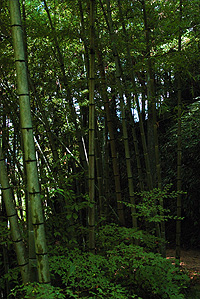
(Magome, Nagano, Japan)
There was an incredible amount of forest cover between our two destinations and this was thanks to the fact that Japan had wars with both Korea and China which consumed vast amounts of wood for ship building and threatened to deforest Japan in the seventeenth century. In response to this the Tokugawa Shoguns (yet again) put in place very strict guidelines governing forestry. In fact just outside Magome is a board stating the penalties for various crimes and illegal logging was punished with the death penalty! As a result Japan today has the largest percentage of forest cover of any developed nation. The figures I read stated that about 70% of the country is still covered in forest. This is pretty amazing when you consider how built up the rest of the country is and the pressure there is for space. However this has come at a cost, in order to fuel its demand for paper Japan is a huge importer of wood chips from Australia. In effect Japan has sustained its forests at the expense of other countries. So whilst it looks like a very environmentally friendly country it in fact is just as bad as any.
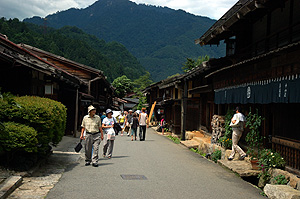
(Tsumago, Nagano, Japan)
The hike was not too strenuous but the heat made it seem a lot longer than the 7.7km it actually was. We went over an 800m pass and then descended slowly to Tsumago following the course of a river. Tsumago itself was very interesting. Whilst Magome is very polished, Tsumago was a ghost town until about thirty years ago and some of its houses still look a little worse for wear. We had lunch in a very nice restaurant which opened at the back to a garden and then headed back to Magome.
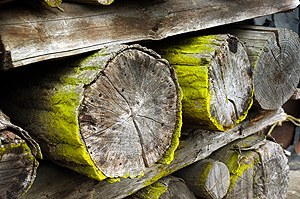
(Magome, Nagano, Japan)
We got back to Magome at around 1500 so decided to chill out in a cafe we had seen the day before which had a terrace at the back with a wonderful view of the mountains. That was pretty much it for the day, we had a bit too much to drink then went for dinner at our hotel which again was high on the bowl count then retired to our room.
Wednesday, 17 August 2005
Norikura Kogen, Nagano, Japan
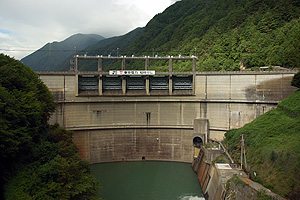
(Norikura Kogen, Nagano, Japan)
We tried to get off to an early start but messed it up by not checking the bus timetable. Because of the lengthy breakfast proceedings we managed to miss the early bus back to Natsugawa by about ten minutes and so had to wait an hour and a half for the next one. When it finally arrived we got to the station and found a train to Matsumotto waiting for us, then at Matsumoto caught a local train out to a southern suburb called Shin-shimashima where we again found a bus waiting for us to go up into the mountains.
The centre of Honshu consists of a massive mountain range nicknamed the Japan Alps the heart of which lies west of Matsumoto. The hub of climbing and hiking was a place called Kamikotchi but our guide book had painted such a black picture of getting accommodation and buses in and out that we had decided to go to a spa town a bit south of it called Norikura Kogan.
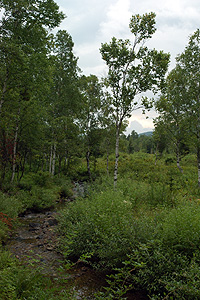
(Norikura Kogen, Nagano, Japan)
The bus journey up into the alps was pretty spectacular. We spent most of the journey travelling up a series of cobalt blue reservoirs surrounded by unbroken forest, and the rest in tunnels of which I counted nine. We were finally getting off the beaten track and although I knew we were heading for what was pretty much a ski resort rather than a bona fide village I took comfort in the mountain scenery.
The hotel we were staying in was not so hot though. The rooms were decorated with a weird Victorian style embossed wall paper, soft single beds and brass and etched glass light shades. Our bathroom was one of those very Japanese one piece pre-fabricated efforts where the bath is extruded from the floor. There was also a strange eggy smell about the place and it took us a while to wok out that this smell permeated every building in Norikura for reasons I reveal below. On the other hand the landlady was very nice and spoke perfect English, however she was a little too Fawlty Towers, I guess in a way we prefer the impersonal touch.
We arrived about 1500 and as soon as we dropped our luggage off it started to drizzle so we did not set our sites too high and went for a 5km or so walk through a sort of nature park just to the south of where we were staying. The weather did not improve much and as it got darker the mosquitos started to appear and I got my legs bitten up yet again. After this it was time for dinner. This was very nice but once again the Fawlty Towers effect came in to play and we had to endure a looped tape of "Richard Claidermann plays Love Melodies" through our entire meal.
Thursday, 18 August 2005
Norikura Kogen, Nagano, Japan
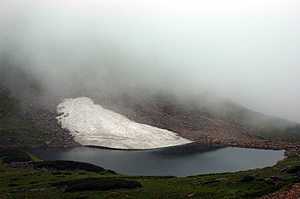
(Norikura Kogen, Nagano, Japan)
We got up early to catch the 0800 bus up to the peak of Mount Norikura. I would like to pretend we climbed all the way to the top of its 3027m peak but this would have involved a 12 hour hike and we had other more relaxing tasks in store that day so we took the short cut. The bus was completely packed out. When we arrived at the bus terminal there were already about 20 people with backpacks and thermoses queued up and a man with a clipboard organising passengers. When the bus came everyone was put into the bus in the order they had turned up and the bus left exactly on time.
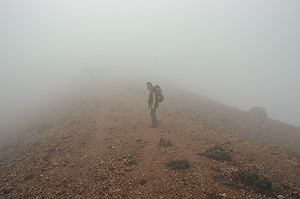
(Norikura Kogen, Nagano, Japan)
The journey up took about fifty minutes an once there we were turfed out into a car park overlooking a small glacial lake surrounded by gift shops and a Shinto shrine. This would have been 100% normal except for the fact that we were at 2500m. We attempted to buy something for our short hike however all we could find in the way of supplies were some apple flavoured kit kats which as it happened tasted foul. Then we were off. It was not much of a challenge and we got to the peak in about three quarters of an hour. The best thing was that the temperature and almost constant mist reminded me very much of hiking in England. When we reached the peak (which also had a small Shinto shrine complete with Monk) we could not see anything and just had to trust the signposts that we had reached our goal. We went down via a different route alongside which were the remains of a snow field, which for August was pretty impressive.
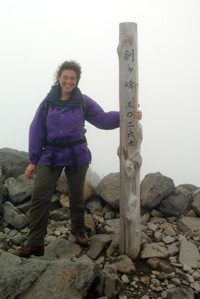
(Norikura Kogen, Nagano, Japan)
Our afternoon was set aside for a relaxing visit to the rotemburo, or open air baths. Norikura like a lot of mountain resorts in Japan is an onsen, or hot spa town (which explained the eggy sulphur smell which permeated the entire place). Thanks to the volcanic nature of their country the Japanese have a vast number of onsen towns and have developed an entire ritual around bathing. According to our guide book wherever you drill in Japan you will hit a source of hot water it is just a question of how deep you have to drill which determines how expensive building an onsen is.
We went to the Norikura public onsen not entirely knowing what to expect. We were segregated into a women's spa and a men's bath, apparently a fairly recent development because for many years baths were mixed. Then, after stripping off, you get to a showering area where everyone sits on small stalls and washes themselves. Because again the bath water is communal you are expected to get every last sud of soap off before you get into the water. In the Norikura onsen there were then two areas, an outside bath or rotemburo, and an inside pool. I went straight outside as the sun was shining and lowered myself into the milky white waters of the pool. I was surprised as everything I had read led me to expect that I would be stepping into scalding hot water and shrieking my head off. But actually it was not too far off the temperature you would run a bath at home.
After this the ritual was pretty free form. It appeared that you spent a bit of time in the hot pool, then got out and cooled down, which allowed me to contemplate the peak of Mount Norikura stark naked, then plunged yourself back in. I did this a couple of times then tried the inside pool which was a bit hotter but still bearable. The part of the ritual which I and a few others skipped was putting your towel on your head. Whilst I was in the outside pool a couple of blokes folded up their towels and balanced them on their heads before coming into the water. As unlikely as it seems what I had read was that this made the heat easier to deal with.
After drying off and dressing I met up with Anna and we went for a few beers in an outdoor cafe. This was very relaxing after the hot pungent waters of the spa and for once the sun was shining. I even managed to get sunburnt for the first time since we had arrived in Japan! After 1700 it started to get dark and pretty much everything in Norikura started to shut down so we headed back to the hotel for dinner. Again our very motherly land lady fussed over us whilst we ate and at around 1900 we ran away to our room. The countryside of Japan was proving very boring and as I was about to finish the only book I had taken with me I was a bit worried about how I would last at our next destination.
Friday, 19 August 2005
Hakuba, Nagano, Japan
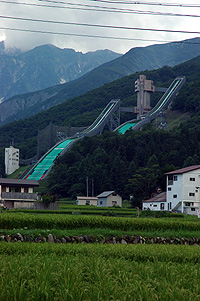
(Hakuba, Nagano, Japan)
We woke up early and had breakfast early to catch the 0710 bus back to Matsumoto. Again we had a way to go and did not want a repeat of our trip from Magome. In the event we need not have worried, the bus was timed to meet the train from Shin-shimashima and at Matsumoto we only had to wait about three quarters of an hour for an express train to Hakuba. In Hakuba the tourist information office found us a nice hotel but we again could not check in until 1500 so we dropped our bags off and went to explore the place.
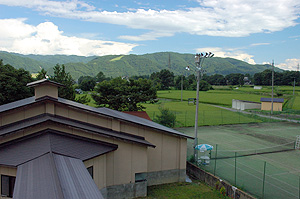
(Hakuba, Nagano, Japan)
Hakuba was by a long way the most attractive place, in terms of natural beauty, we had been so far. The town was in a small flat valley no more than three kilometres across with 3000m high mountains surrounding it. More crucially it was the main venue for the 1998 Winter Olympics so has quite a bit of accommodation and has good access to all of the mountains around. I do not think there had been a lot there before the Olympics because our hotel, like a lot of them, was completely surrounded by green rice paddies. We arranged a few things then went for lunch at Gravity Worx a pizza place in town where the owner grew all her own vegetables and herbs on the premises. It was a welcome break from the complexities Japanese cuisine.
That afternoon we did very little apart from check out our hotel's own onsen, which had a sauna and a rotemburo. Although quite costly the hotel was pretty luxurious and our room had a wonderful view of the mountains.
Saturday, 20 August 2005
Hakuba, Nagano, Japan
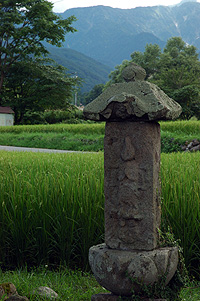
(Hakuba, Nagano, Japan)
After an amazing Japanese breakfast with another very high bowl count we went to the hotel's onsen again. Funnily enough we got so used to the whole onsen ritual that although we had an en suite bathroom we did not really use it. We would stroll down to the onsen in our cotton yukatas, have a shower then soak in the rotemburo. Its a great way to start the day although funnily it would be completely empty in the mornings, most Japanese preferring to bathe in the evenings.
After this we set off to do some white water rafting. We had arranged this as a bit of a time filer, the real focus of the day was getting ready for some hiking the day after. However in the end it was reasonably exciting. We spent a good half hour getting kitted up and another half hour on a technique and safety briefing in Japanese. Fortunately we had already rafted and the guide on our raft (there were about six rafts) spoke reasonable English so was able to tell us what the basic commands were.
The rafting itself was an hour at most. Sections of the rapids were apparently grade three but there was very little chance of anyone falling out and most of the fun was in trying to drown the people in the other boats. The rafting was then followed by a very bizarre experience, we were taken to an onsen/shopping complex and were left there for about an hour. I was not sure what this was about but withe forty odd people simultaneously turning up the onsen was unpleasantly packed. Plus since we had left our money at the rafting centre we had no money to shop with even if we had wanted to.
When we finally got back to town we then went to a local supermarket to stock up for our hiking trip. We had decided not to pack a camping stove in the interests of travelling light which meant that we had to survive on pre-prepared food. The super-market had a reasonable selection and we got ourselves quickly kitted out however we spent most of the time trying to work out what everything was. The supermarket carried a huge range of pickles, most of which we could not identify, but however we did find a bag of pickled grasshoppers which was rather tempting.
After this we went for some dinner at a small restaurant. I had a tonkatsu meal set which consisted of a breaded pork cutlet, a bowl of noodles and a bowl of rice. Anna ad an enormous bowl of udon.
Sunday, 21 August 2005
Hakuba, Nagano, Japan
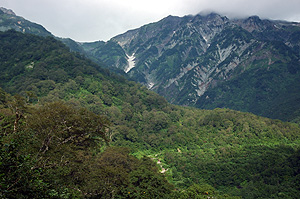
(Hakuba, Nagano, Japan)
We got up early to catch the 0645 bus to Sarukura. We had selected a trek which involved going to the top of the 2932m Shirouma Dake, spending a night just below the summit, then traversing a ridge to the 2903m Yari-ga-take before descending back to Hakuba.
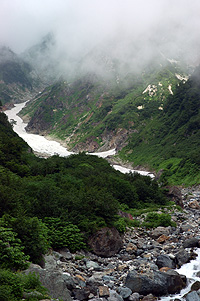
(Hakuba, Nagano, Japan)
The bus dropped us off at Sarukara a small hut at 1250m at the head of a trail up into the mountains. The start of the walk was a leisurely hour walk alongside a river to Hakuba-jiri-goya hut. The next bit was far from leisurely, the Japanese alps have smallish glaciers all year round and it appeared that the fastest way to the top of Shirouma-dake was to walk up a glaciated valley known as Daisekkei or the great snow valley. It was an awesome experience, we were shrouded in mist and blasted by freezing cold air. We knew that the glacier portion of the trek to the top was extensive but because of the limited visibility we never knew how much more we had to go. Fortunately the hordes of people that had gone up there in July an early August had beaten a track which meant that crampons were not necessary. However the gradient was around 30 degrees and the couple of times I slipped over were a bit worrying.
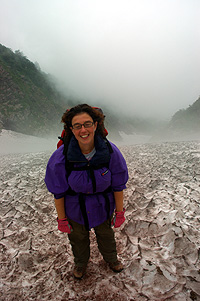
(Hakuba, Nagano, Japan)
After about an hour and a half we finally got to a small spur of dry land that we scrambled up for another three hours. It was during this part of the walk that we began to notice the flowers. The Japanese have carefully preserved the alpine meadows by roping in the tracks that go up the sides of mountains and so stopping the flowers from being trampled. There were a lot in flower at the time and the Japanese seemed to be very keen botanists, frequently stopping to take pictures of various species with their mobile phones.
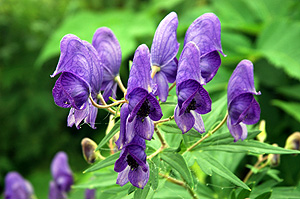
(Hakuba, Nagano, Japan)
When the ground finally started to flatten out and we caught sight of the 2730m Chojo Shukusha hut we were to say the least relieved. We had ascended 1500m in four and a half hours and were getting a bit tired. We found the sheltered campsite behind the hut and set up our tent before having some lunch. Then, without our packs, we ascended the remaining 200m to the peak of Shirouma-dake in about half an hour for the obligatory photo shoot. One problem that was too plague our short hike was the amount of cloud cover. We hung around long enough to be rewarded with a momentary glimpse of the surrounding peaks and glaciers, however we never got to see much more than this. Worse still as we descended back towards our camp it started to rain, and we were pretty damp by the time we got back at around 1500. We climbed into the tent and since there was no let up in the rain were trapped there for the remainder of the day.
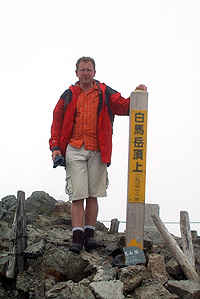
(Hakuba, Nagano, Japan)

(Hakuba, Nagano, Japan)
It is worth explaining a bit about huts at this point. When you think of alpine huts you think of small cabins able to fit around ten people. Chojo Shukusha hut and neighbouring Hakuba-sanso hut were able to fit a total of 2,500 people between them. This says a lot for the popularity of hiking in Japan. Although we had come at the end of the summer hiking season we had passed a fair number of groups and it was easy to see that at peak periods these huts could be full. We tend to think that we are fairly keen hikers in the UK but the thought of accommodating and feeding 2,500 people on the top of Ben Nevis puts this into perspective. Anyway our tent spared the huge dormitories but were able to enjoy one of the luxuries, they had also airlifted a beer vending machine up there so we were able to enjoy an Asahi with our cold dinner whilst sheltering from the rain!
Monday, 22 August 2005
Hakuba, Nagano, Japan
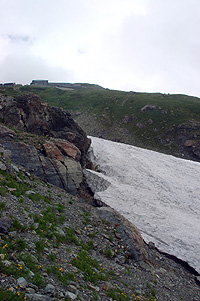
(Hakuba, Nagano, Japan)
It rained hard all night long. We had a lightweight tent with us that had stood up well in all sorts of conditions but unfortunately its groundsheet must have had a small hole in it and a little water welled up into the tent from the ground. We were only spared a complete drenching through our inflatable mattresses. Worse still at around 0200 a gale started blowing and the full flexibility of our tent poles was tested out. It had proved difficult to get the tent pegs in, so in a couple of places I had improvised using rocks. Fortunately these held and we were spared a thorough drenching through the outer and fly sheet touching. Our ability to sleep through this was not aided by the fact that a group of students in a neighbouring tent decided that rather than try and sleep through the howling gale they would stay awake and chat. This meant that even in moments when the wind abated we could hear them nattering away.
To say the least we woke up cold, damp and tired. Although we had dry thermals for sleeping in we were forced to put on our coats which had got slightly damp from the day before but had little chance of drying off during the night so the moisture had seeped all the way through. We had a breakfast of biscuits and then packed up the tent in the pouring rain and set off.
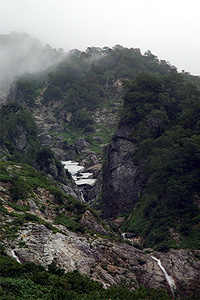
(Hakuba, Nagano, Japan)
Walking along a 2500m ridge in nice conditions is an absolute joy. The stunning views and the fact that you are never ascending and descending too far are what a lot of hikers live for. However walking along the same ridge in pouring rain with strong winds and 50m visibility takes most of the fun out of it. It was a very wet start to a very wet day. We walked for about an hour and a half before we reached the summit of Yari-ga-take and then got into a bit of a panic about which direction we were meant to be heading. Although we had a map I had stupidly put it in the pocket of my shorts and it was now sopping wet. More importantly nothing on the sign posts matched the Katakana characters on the map and, having packed in a hurry, we had no compass. Fortunately out of the gloom appeared two female hikers clad in orange waterproofs and, although they were not terribly convincing, we managed to work out that we were all heading to the same place and which direction we had to follow.
This involved plummeting off the ridge to descend 600m in the space of two hours. At least we were now sheltered from the wind but the rain did not let up. We went through switch back after switch back and just as we thought the descent could not get any steeper and our feet any wetter we were forced to descend backwards and forwards down an almost sheer rock face. We shuffled along tiny ledges, grasping chains bolted to the rock desperately trying to ignore the drop below us. The fun was increased by the fact that a waterfall gushed down the middle of this rock face and so we had to step through this and at one point lower ourselves down a section of it whilst water poured into our boots.
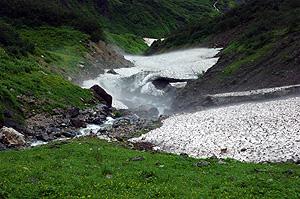
(Hakuba, Nagano, Japan)
There was a certain amount of relief a few minutes later that we spotted the roof of Yari Onsen. Unfortunately because the going was so tough in the rain I had put my camera into my rucksack and so do not have a photograph of Yari Onsen but it was quite the most remarkable place. Perched on a steep cliff side at 2000m the small collection of huts and pools overlooks a glacier 100m below. Moreover just below the onsen the glacier is broken in two so what you see is a waterfall gushing out of the end of one glacier down onto the next. The hot waters of the onsen empty out into the glacier so, even if the clouds were not present, steam and spray rise up from the glacier. On top of this the surrounding vegetation was almost like a jungle. The rotemburo was a huge rocky pool tinged blue from the minerals in it. Interestingly it was also completely open so when we later passed in front of it a very surprised nude dude quickly tried to cover himself with a towel as Anna stared in.
We had our lunch under the plastic covered verandah which surrounded the huts of Yari Onsen, whilst our coats hung up on a rail to dry. Quite a few people were also caught in the rain and so the verandah looked like a small laundry with clothes all over the place and various people cooking lunch on camping stoves. We had wanted to take a bath in the rotemburo but we had made pretty slow progress and needed to be back at our starting point to catch the last bus of the day at 1620. So after some more biscuits and a rice parcel we headed off into the rain.
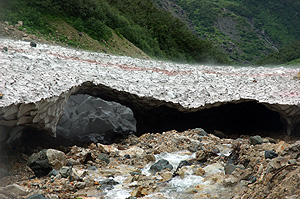
(Hakuba, Nagano, Japan)
The first part of the continuing downwards trail was spectacular. I managed to get some photographs as the rain let up for a while, but my lens kept fogging up so they were a bit feeble. Basically we had to traverse several ravines in the valley we were in to get to a saddle and descend into the valley we had started the trek in. The traverse was spectacular, walking through a semi jungle with every ravine containing a glacier or a waterfall or both. We were continually going up and down to navigate around landslides and glaciers so after about the first hour our legs started to get very tired.
The second part of the descent was much more arduous. Rather than going up and down we had a slow descent along a path which had turned into a river as a result of the rainfall. I suppose I should not complain as in the UK it would have been a lot more muddy but the small boulders and constantly wet feet meant a lot of stumbling and really took their toll on my ankles. We trudged through this for nearly three more hours until we finally got back to Sarukura. We were wringing wet and in a wretched condition but made the last bus with half an hour to spare drinking a beer.
Once back at the hotel we virtually collapsed into the onsen to revitalise ourselves. However our problems were not over yet. We wanted to leave the next morning and everything we had taken with us, including our rucksacks was wringing wet. The hotel being kitted out for skiing had a drying room but, since it was summer, it was not very warm. Nevertheless we hung everything up in the hope it would be ready by the check out time the next day. Everything taken care of the best we could it was time for dinner. And where else would two worn out westerners go in Hakuba but Gravity Worx for more pizza, pasta and chocolate mud pie!!
Tuesday, 23 August 2005
Shimoda, Shizuoka, Japan
We had made a rather expensive decision to not go somewhere between Hakuba and Tokyo for our final stop. We had realised that in the two weeks we had spent in Japan we had not been near the sea so it was time to go to the beach. We researched a couple of places but decided in the end that Shimoda on the end of the Izu Hanto (peninsula) would be the simplest place to head for. Formed by lava flowing from Mount Fuji the peninsula has a spectacular coast line and has the advantage of not being too far from Tokyo. However we would still have to go via Tokyo and the journey would involve a bus, two bullet trains and a local train. It would also take seven hours and a lot of cash.
The first hop was a bus to Nagano, the prefecture's capital and the host city of the 1998 winter Olympics. We then took a shinkansen to Tokyo and were whisked there in about an hour and a half. In Tokyo's central station we were then faced with a bit of a puzzle, although there were direct trains to Shimoda we were told that it was cheaper as well as faster to take a bullet train to a place called Atami and change to the direct train there. Not wanting to argue we did exactly this. The second bullet train of the day was just as efficient as the first. Our only gripe was that we had wanted another bash at seeing Mount Fuji and being a much clearer day than two weeks ago we thought we would have a chance but unfortunately Atami was not far enough west to catch a glimpse. The final hop of the day down the Izu Hanto as tortuously slow, although the train does follow a coast hugging route which made the journey very scenic.
Our hotel in Shimoda, the Marseille, was a typical Japanese business hotel which had the luxury of having a MacDonalds on the ground floor. We were up on the top floor and since at seven stories the building was pretty much the tallest in Shimoda we had a nice view. Shimoda is a harbour town hemmed in on three sides by low tree covered mountains which protect it from the sea. It is famous for being the first port opened up for international trade after the isolation of the Shogunate. Commodore Perry, an American, landed here in the 19th century and was allowed to set up an embassy and trade with Japan. For a while it was the principal link with the outside world before Yokohama was also opened up a few years later.
After all the travelling we had arrived at around 1700 so that did not leave a lot of time for sight seeing. However even if we had wanted to we could not because after the previous day's exertions both of us aching legs and swollen ankles. We decided to just go for some dinner and call it a night. The restaurant we chose, Gorosaya, did a nice trade in set meals. Because the only other option was sitting on the floor, which our legs would not allow, we sat at a counter which meant we were looking straight at the two chefs preparing the food. I chose the sashimi set and as you would expect from a port the quality of the fish was amazing and I even managed to gulp down my raw prawn and a couple of raw squid rings. Two Japanese people next to us were ordering a la carte from a Japanese only menu and were getting all sorts of weird shellfish including huge whelk like shells that the chef drowned in sake then put straight on the hob to cook. In comparison Anna's choice of grilled fish looked a bit tame and this annoyed her a lot!!
Wednesday, 24 August 2005
Shimoda, Shizuoka, Japan
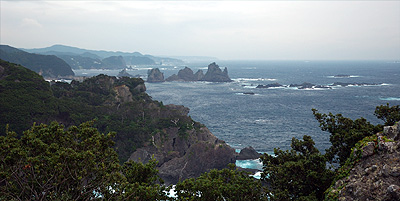
(Shimoda, Shizuoka, Japan)
We woke to a howling gale. We knew from watching the news that there was a typhoon on its way but we were not expecting it until the next day. Instead of going straight to the beach we decided to get a bus to Iro-Zaki, the tip of the peninsula which was meant to be very scenic. It did not disappoint, black volcanic rock islands with pine trees gripping to their tops and the waves crashing at their bases provided an absolutely picture book image of Japan's coast. Unfortunately, as always, we were there at the wrong time of the day and the gloomy skies did not make for very good photographs.
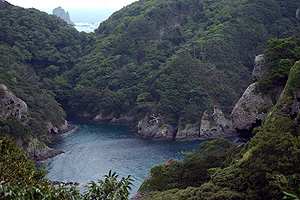
(Shimoda, Shizuoka, Japan)
Whilst we were exploring Iro-Zaki the weather did however start to improve. We regretted having left our beach stuff at the hotel and so once we had finished exploring the rocks we had no choice but to go back to Shimoda. This also meant being stuck in town for half an hour waiting for another bus. We decided to use this time to get some lunch. Near the hotel was an excellent kaitan zushi (conveyor belt sushi) restaurant where yet again I had some top quality raw fish.
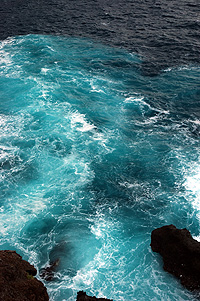
(Shimoda, Shizuoka, Japan)
Kisami beach, when we finally got there, was again picture book. It was a short stretch of golden sand backed with trees and mountains and several islands just off shore. Unlike a lot of beaches in Japan it was relatively undeveloped and without hotels everywhere it was very idyllic. The only problem was that it was not very sunny and it was incredibly windy. However the wind did have the advantage of creating huge 3m high waves which had attracted a few surfers and allowed us to do a bit of very amateur body surfing. We stayed until about 1630 and then caught the bus back into town.
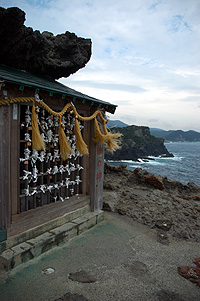
(Shimoda, Shizuoka, Japan)
That night we had decided that rather than more raw fish we would go to a Yakiniku restaurant called Shoya. Yet another in the bewildering array of restaurant styles in Japan, Yakiniku involves cooking you own meat and vegetables on a small burner in the middle of the table. When we first arrived we panicked a bit because there was no English menu, however after a few minutes one of the chefs was brought out of the kitchen and he turned out to speak almost perfect English. We went with his recommendations and started with an assortment of Kimchi (Korean pickled vegetables) and a layered dish of tomato and some delectable sauce. Next we had decided to brave some "cherry blossom meat", and we were very brave as this is in fact what the Japanese call horse meat. Completely raw and in fact semi frozen the horse meat was cut into small rectangles which you dipped into garlic paste and soy then ate. It was incredibly nice and not at all what I had expected. We had drawn the line at eating whale and we were not particularly happy about the fate of the horse but I figure that if its not an endangered animal you should at least try local delicacies!! The yakiniku part of the meal was just as good. Anna had been very brave and elected to eat offal but I had beef which again was beautifully marbled. The cooking of the meat was pretty simple, you just plonked it on the hot plate and then fished it out once it was done. Again I marvelled at how many ways the Japanese had figured out for you to cook your own meal!!
As the restaurant was very popular, with every table booked up and people queuing up, we decided to free up our table and go for a couple of beers to round off the evening. I had spotted an odd bar the night before so we went off to find it. The "Cheshire Cat" turned out to be a Jazz bar run by an absolutely crazy Japanese guy who apart from a top knot had a completely shaved head and used to play the trumpet professionally.
The only other person in the bar was a Canadian called Kevin who had saved up to travel for three years and had come to Japan after a long stint in South America. I had blanked the odd guy who tried to befriend us in Tokyo mainly because I was not really interested in hanging out with westerners. However since we had left Osaka we had only seen two or three non Japanese and so we were needing to reintegrate ourselves into society. Besides which Kevin was a really nice bloke and as we got increasingly drunk we chatted about a lot of things. We learnt from the owner that when you say "Gampachi", or cheers, in Japan you have to stare your fellow drinker in the eye otherwise you are doomed to have seven years bad sex. We also persuaded the owner to participate in a Jazz trio with Anna on the piano and Kevin on the drums. By the end of the evening everyone, including the owner, was completely drunk - it was a lot of fun!
Thursday, 25 August 2005
Tokyo, Japan
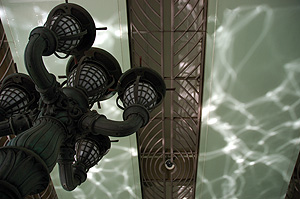
(Tokyo, Japan)
Waking up with hangovers we looked outside to see that the typhoon was really starting to hot up so decided to get out of Shimoda as quickly as possible. The wind was very strong and there were frequent bouts of heavy rain. Our attempt to get some breakfast revealed that most businesses were closed at 1000 so we were forced to grab something at MacDonalds, conveniently located in our hotel lobby, before getting on the train.
We managed to find a slightly faster direct train and as it trundled its way up the coastline of the Izu Hanto we realised that we had made it out just in time as huge waves were lashing the coastal defences at several points. We got to Roppongi at around 1400 and hung around in a clone of Starbucks just around the corner from our hotel until we could check in at 1500.
It took us a while to get ready but eventually we left the hotel bound for the Ebisu district of Tokyo to see the Photography museum. This turned out to be mixed. There was an excellent exhibition of works by Brassai, a French photographer, a revealing exhibition of B&W Japanese photographs from immediately before and after WWII and an amazing exhibition of contemporary images from all over Japan. However whilst the war photography was labelled in English and the Brassai in French, the contemporary images were only in Japanese. This was very frustrating as these were very interesting in terms of showing different places in Japan some of which we might have returned to visit if only we knew where they were!!
Ebisu itself was pretty interesting. The photography museum was in an area called Ebisu garden city which seemed to have been formed by roofing over the roads and the building a completely new layer of trees, wide pedestrian boulevards restaurants etc. two stories above ground level. It was not an uncommon concept in Tokyo which has so many raised pedestrian walkways, double level expressways and business on every floor that it is easy to forget that you are not at ground level. I think that the principle would work well in downtown Manhattan. They could sacrifice the lower tiers of their skyscrapers and roof over the appalling roads and create an urban pedestrian paradise. Of course it would not be so great for historic buildings such as churches etc. which Tokyo has very few of, but I am sure something could be done.
After the photography museum we walked out to find that the rain in Tokyo had become a lot heavier. One interesting thing I noticed because of the rain was that umbrellas are quite ubiquitous in Japan. It seems a bit of an odd observation but the majority of people seem to sport cheap plastic umbrellas which cost around Y2 and seem to be available everywhere. In restaurants and museums there are lockable umbrella racks and these always seemed to be stuffed with the things. It was almost as if rain was so unpredictable in Japan that a lot of people buy umbrellas on the spur of the moment and so think nothing of sporting a very cheap one.
We went for dinner that night in Ebisu at a modern restaurant that turned out to be Californian. It was pretty nice, I had tuna and Anna had some amazingly well prepared lamb. One thing hat amused me however was that when I went into the gents toilet it automatically started playing a loop of the sound of running water!!
Friday, 26 August 2005
Tokyo, Japan
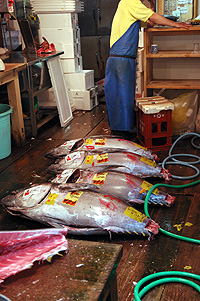
(Tokyo, Japan)
We had planned that our last full day in Japan was to be taken up with a couple of attractions we had missed our last time round in Tokyo, along with the necessary shopping trip. Our first stop was Tokyo's Central Wholesale Market at Tsjuki. Although it seems like an unlikely destination the market primarily deals with fish and starts operating at 5am in the morning when the various catches arrive and are auctioned to the wholesalers who then sell it through their stalls to restaurants etc. We turned up at 8pm, too late to see the auction but early enough to still see a few of the colossal frozen tuna being carved up and sold on.
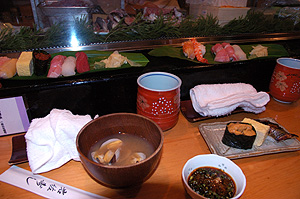
(Tokyo, Japan)
The market was buzzing, unsurprisingly for a nation so keen on raw fish. Every sort of fish and shell fish imaginable was on sale with quite a percentage of it still alive and flailing around in small tanks. We walked up and down the colossal market a couple of times, taking a few photographs and marvelling at the scale of it. However we were very eager to try as well as gawp so after this headed to one of a small row of tiny sushi stalls just to one side of the market. Our choice was a small place with a row of ten seats and a couple of sushi chefs. Rather amusingly a sushi magazine seemed to be doing a bit of a feature on the place and a photographer was taking pictures of sushi just inside the entrance. We ordered a Nigiri set and were not disappointed. The quality and freshness was well above what we had experienced in conveyor belt sushi joints and the variety was amazing. The biggest delicacy was some fatty tuna. Rather than the very red tuna meat you normally see this was slightly pinkish and seems to be more highly prized by sushi lovers. We also had some weird conch like shellfish that the chefs had expertly butterflied and laid on top of a rice package.
After stuffing ourselves so early in the morning it was time for a bit of retail therapy. We first went to Asakusa in the North of the city where we hoped to find some original shops. In the end it was a little disappointingly touristy but we did find a great shop which made hand printed Tenougi. These are the miniscule cotton towels (a bit like tea towels) that you are given in onsen to dry yourself with. This particular designer has apparently rekindled the art of hand printing designs on these so we bought a couple, not sure if they were too nice to be used in a practical context.
However what I had really been looking for was Yukata, the bath robes which you are given at onsen (well at the more luxurious ones). Apparently these date from the time of the samurai and are again cotton and the best looking ones have pretty simple designs. In Asakusa they had them but they seemed of dubious quality and too gaudy so we decided to go to Ginza to see if the department stores could do any better.
When we got to the first of the stores near Nihonbashi (the original entrance to Tokyo) the answer seemed to be yes. We found a nice selection of minimal designs of a very good quality. However when we looked at the price tag we found out why each one Y150+ which seemed a lot for a bath robe. It was a similar story at the next three stores we went into but finally in the last one we lucked out and found a selection of nice simple yukata at a reasonable price. It was an exhausting shopping trip and we concluded that our guide book had not been of much help as it concentrated around the tourist trap of Asakusa, and Ginza which is the equivalent to the Bond street of Tokyo. We were pretty exhausted after all the running around so decided to stop for a beer and some sauerkraut in a cavernous German beer kellar.
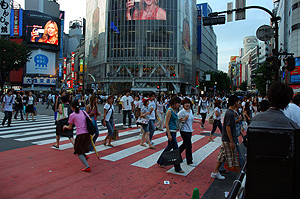
(Shibuya, Tokyo, Japan)
Our final stop of the day was an area to the west of Tokyo called Shibuya. If you travel around any city only by metro you tend to only see it a a series of disjointed areas and its not until you start walking between places that you finally see it as a whole. However stepping out of the subway at Shibuya was like entering a whole different city. A popular meeting and night time place the crowds in Shibuya are hard to describe. People are rushing past in all directions and, with several levels of glass walled aerial walk ways, above and below you. Above this a mammoth five storey television screen projects various images including life sized animations of elephants walking through the air.
However the reason we were there was not to gawp at elephants, we were there to explore "love hotel hill". Again a very Japanese concept the love hotel caters to the young inhabitants of Japanese cities who live with their parents until a very late age, even after marriage. Japanese apartments tend to be pretty small and so with everyone living on top of each other or separated by paper screens its very difficult to get any privacy. Thus love hotels sprung up to serve the needs of young couples by renting rooms by the hour. Shibuaya has the most famous concentration of these in an area known as "love hotel hill".
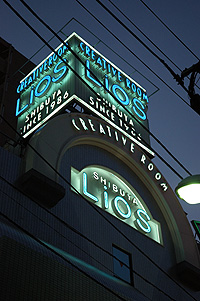
(Shibuya, Tokyo, Japan)
We walked uphill on a road called Dogenzaka looking for the tell-tale sign which is a hotel with a board outside with two prices, one for a night's stay and the other for a "rest". However we needn't have bothered hunting so hard because half way up the hill was a bright pink and blue building lit up with neon called "Hotel Casanova". We walked over to it and down a passageway next to it found a maze of alleyways each crammed with hotels off various colours and equally amusing names.
The basic formula for a love hotel is that you go in via an automatically opening entrance concealed from the road by a small wall. Once in you will find a display of pictures of rooms each with a button next to it. You can tell which rooms are free by the fact that their picture is lit up. Each picture details the facilities of the room and next to it is a button. You press this to take the room, after which you have to go to the cashiers desk which is a tiny hatch intentionally positioned at waist height so they cannot see your face.
However beyond this we unfortunately have not got too much to shed light on. The problem was that we went to the area with good intentions but nothing really took our fancy. Most of the rooms just looked like very plainly or gaudily decorated hotel rooms with not too much else going for them. Worse still most of them were in use!! It seemed stupid to rent one out when we already had a hotel room which was a lot more comfortable. Interestingly I had read an Internet site which revealed that in terms of variety in the "facilities" available in a room Osaka was the best place to go, whilst in Tokyo you would be lucky to find more than a mirrored ceiling. It all seemed very utilitarian and it seemed a shame to occupy a room when at 1800 they were already in short supply and, judging by the number of couples we saw taking them, in high demand!
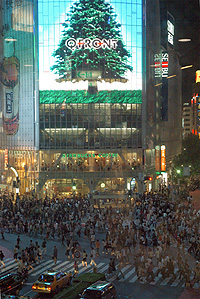
(Shibuya, Tokyo, Japan)
On our last night in Japan, in a city with 300,000 places to eat in, we very boringly decided to go back to Gonpachi in Roppongi. Although its edo era inn style was a theme (and it turns out a chain) the food was good and we thought it was a fun place to truly celebrate Anna's birthday, which had been on the 22nd when we were on the top of a mountain so short of options. This time we sat upstairs in a small secluded booth with a balcony which overlooked the centre of the restaurant and all the action. They had a CD of the Kodo drummers playing and we had skewers of duck, tuna and beef along with some excellent cold soba and their amazing layered omelette.
And that was it for our trip to Japan, we caught a flight back the next morning and got back to the UK on Saturday evening. It truly is hard to imagine a more different place than Japan. It has some of the most sophisticated gadgetry in the whole world yet is also so traditional in some respects. It is incredibly built up in some areas yet the vast majority of the country is still covered with woods and is outstandingly beautiful. A book by an American anthropologist sent to study the Japanese in the 1920's summed it up very well by wondering how a people with a warrior code so violent that they would be prepared to die by their own sword (sepuku) could in turn be so fascinated by the beauty of the chrysanthemum. Although this was said nearly a century ago, you can still see the huge contrasts that exist in Japan. In three short weeks it was impossible to even scratch the surface of Japan - but what we did find out was fascinating and the whole experience unforgettable.





